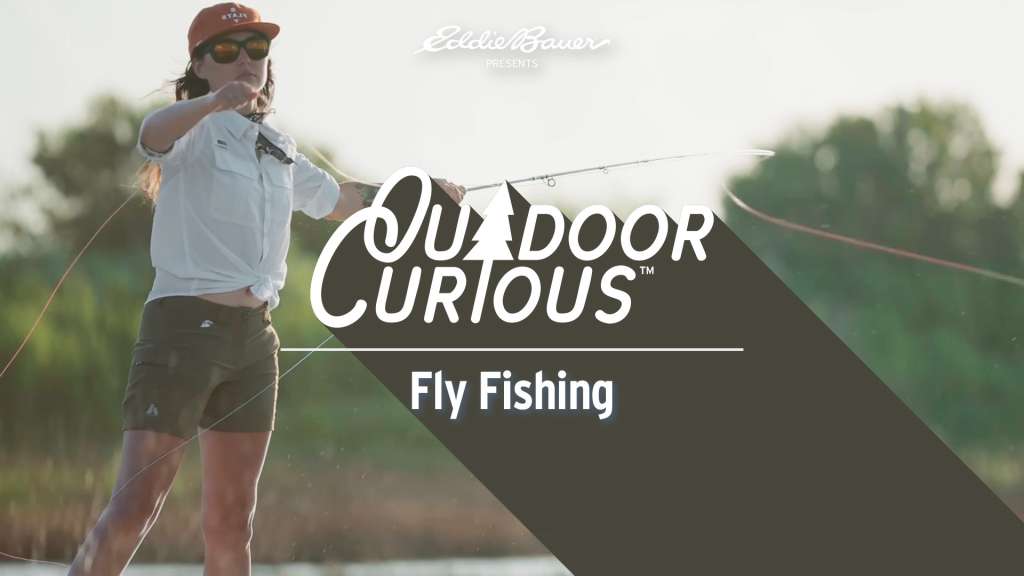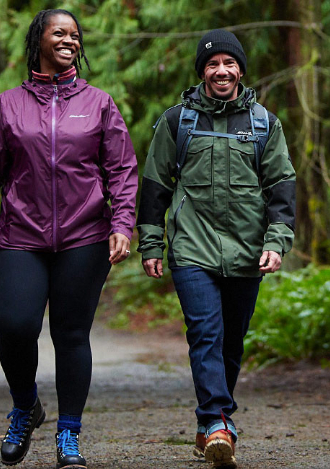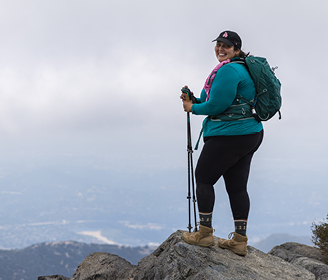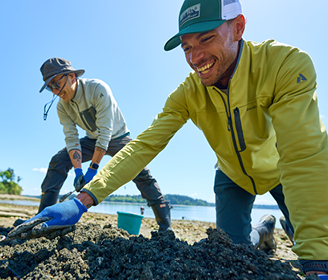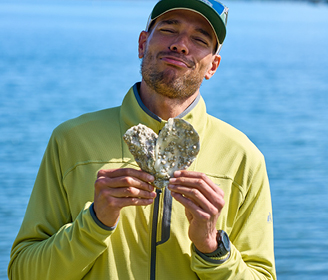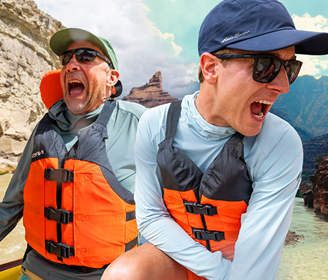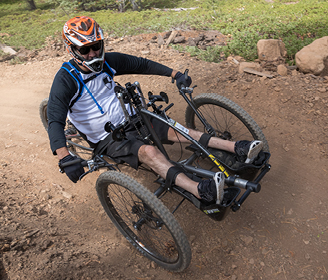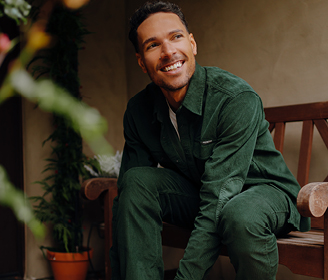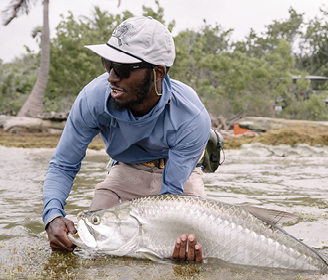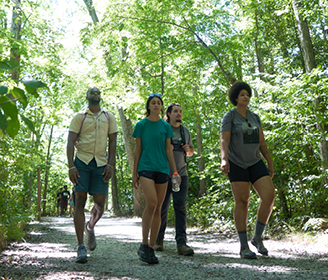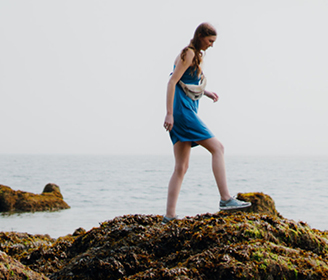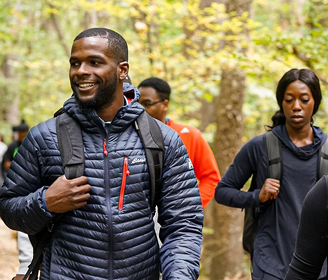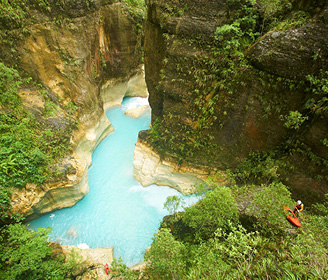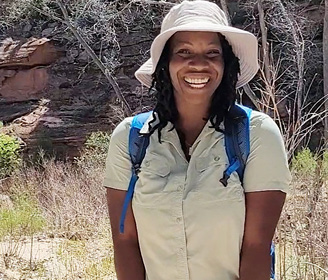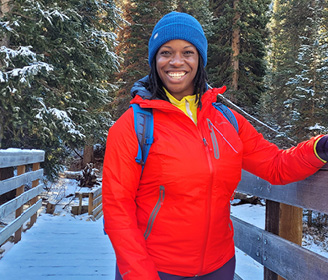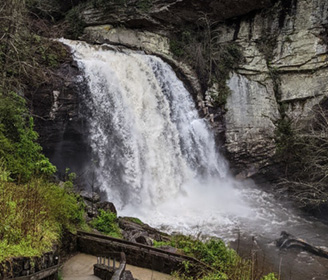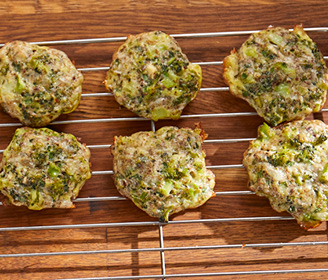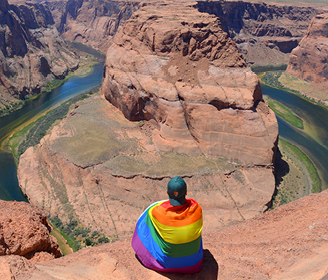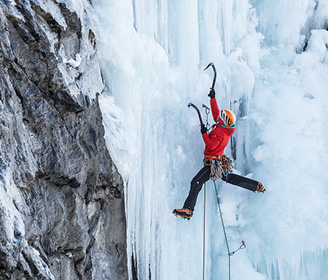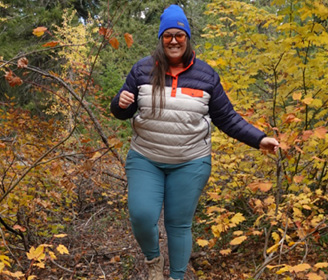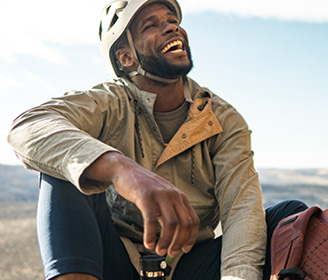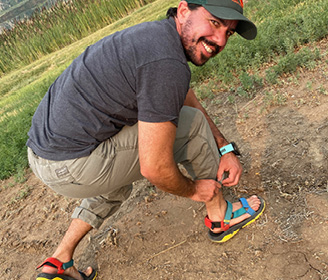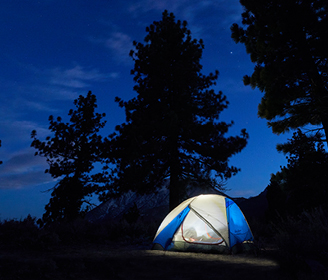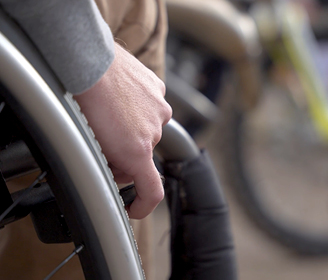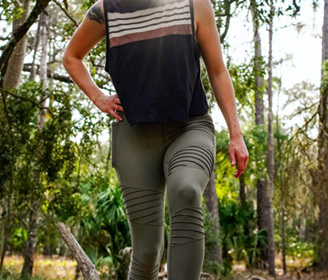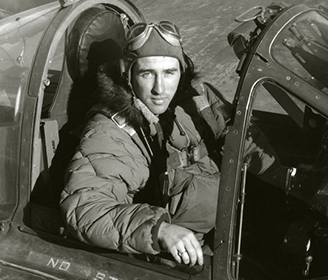Want to know the difference between a leader and tippet? Are you curious about tips for landing the big one? Eddie Bauer guide Caroline Kayla Lockhart has been fly fishing all over the world and works with The Mayfly Project, an NPO that mentors children in foster care by introducing them to fly fishing. She’s here to answer the internet’s most asked questions about fly fishing.
00:31 – What’s the difference between fly fishing and regular fishing fly fishing?
Fly fishing, your fly line is what is weighted and creating your cast and then with regular fishing or gear fishing or conventional fishing, that is where you have a lure or bait, that is what is weighted. And so that would be what projects your cast and loads your rod to make the cast, whereas fly fishing, you have typically an unweighted fly and your fly line is what is weighted and that what creates that bend in your rod.
01:03 – What kind of fish do you catch while fly fishing?
Fly fishing, you can catch any fish you want, it’s just what fish you want to fish for. Whatever your home waters have and hold for fisheries, you can fish for them with a fly rod. Just trying to figure out what they eat, that’s the tricky part.
01:20 – Is fly fishing expensive?
Yes, but there is so many opportunities and possibilities to still make it obtainable. Majority of the cities and areas that you live in, you’ll have local fly shops that you can go to and they have gear that they will loan you. But when you’re starting out, sometimes the price tag of things definitely can stray people away. It did for me at first, when I started. You don’t have to get the brand new rod. You don’t have to have the brand new waders. That’s something that usually you progress into as you adapt to the sport.
01:52 – How many types of fly fishing are there?
There’s dry fly and wet fly fishing. And so the dry fly will be you’re fishing on top of the water or fish that are coming up to eat your fly, and then subsurface, or underwater would be your fishing any hatches or bugs and bait fish and life that would be underwater that the fish are feeding on.
02:15 – What gear do you need for fly fishing?
A positive attitude, a fly rod, and a reel and line and your fly. It’s usually a four piece rod. It can be a two piece and it can be a one piece. But majority of the fly rods that you buy nowadays are four pieces. They’re about nine feet long. You’ll also want to look into a fly box, stuff to hold your flies in whether that’s a backpack or a hip bag and then waders and boots is something that’s really great for me. I don’t really like standing in ice cold rivers. I live in the Pacific Northwest where a lot of them are coastal or glacier fed rivers and so they are very cold. And so the waders and boots just help protect me and keep me comfortable on the water.
03:01 – What do I wear when fly fishing?
Look at where you’re fishing and the weather and the environment. A lot of my trout fishing, I’m hiking a lot, and so I usually like to use a lot of layers, sunscreen, sunglasses, a hat is always great.
03:17 – Can you go fly fishing when it is raining?
I love this question. Well, the fish are already wet, so they will not care if it’s raining. There is definitely days where I’m like, what am I doing out here? And so if it’s ever not fun, don’t put yourself through misery just to catch a fish. But with the rain it’s not gonna bother the fishing. It will definitely change the hatches that are happening in the bug life.
03:42 – What time of day is best for fly fishing?
You can go fishing any time of the day. It’s just all about figuring out what the fish are eating at that time.
03:51 – Do you have to fly fish on a river?
No, you do not. Really, where were you at fish and water and it’s obviously legal to fish there then you can fish it.
04:01 – Do I need a fishing license?
Yes. You always want to look up the regulations. If you have a hired guide, you wanna always ask if you need to get your own fishing license or if it comes with the guide service, almost all places you can buy a fishing license online. Otherwise you can go to your local fly shop and they can help you with that as well.
04:21 – How do I learn how to fly cast?
There’s many different ways. I signed up for classes when I first learned fly fishing. There is fly fishing instructors that you can reach out to and find online. There’s so many different types of casting techniques that you can do. And so YouTube is your friend there. There’s a lot of really great ones. Simon Gawesworth is someone that is an incredibly influential instructor in the fly fishing world. And his videos are really great.
04:50 – What are some different casts to use?
To begin with, an overhand cast and a roll cast are probably the two casts that are gonna help you the most when you starting out for sure. If you have a single head rod over hand cast and roll cast would be the two that I would recommend that you would learn.
05:07 – Does talking actually scare the fish.
Oh, I love this question. This question is pretty nostalgic to me, ’cause I remember growing up and being in the boat in the Midwest with my dad and me and my two sisters just like fighting over who gets to put the worm on or taking the fish off. And he would always yell at us to, “Whisper, you gotta whisper. “Fish can hear you.” So it’s like ingrained in me to believe it, definitely your voice carries and the vibration carries and that can definitely, the fishes have a lateral line that allows them to feel those vibrations under the water. And so if that does carry to the fish, they’re gonna feel it. For example, when I was coming up to a small creek that is spring fed, which means it’s same temperature pretty much all year crystal clear waters. I come in all hot stomping on the ground to get up to the water because I was excited. And my, I felt the two steps I made, I saw the fish spook cause they felt that vibration. And so I guarantee that they can hear your voice too, if it’s loud enough. But when the fish is on hoot and holler all you want.
06:13 – How do I choose a fly to use?
My biggest thing is when you show up to the water, just take a moment and just stand there and listen and watch the water. Chances are a fish is gonna come up and eat something. If there’s a hatch happening and then you’ll wanna look and see, okay, well they’re eating on the top of the water. Okay, I need to look at my dry fly box. Let me see if I can find that hatch, whether that means look at the grass along the river bed. For example, the salmon fly hatch here, on the Deschutes River is infamous. You’ll see these huge bugs with this orange hot spot around their collar and then you’ll know, okay, I need to put a fly on that looks like that.
06:51 – What are the different knots needed to know for fly fishing?
The cinch knot is something that is probably number one that most people use and then a loop knot or Surgeon knot are really popular too. A loop knot is going to create a little loop in front of your fly. And so that little loop lets your fly have action when it’s in the water and then a clinch knot is it’s a knot that’s clinching all the way down to the eyelid of your fly.
07:19 – When is fly fishing season?
Summer, spring, fall, winter, you can fly fish any of those seasons. Anytime you’re going out to new waters or water that you’re not sure, always check the regulations. You wanna make sure that that’s open. Maybe the certain spot on the river is closed but the next section over is open.
07:39 – What is a leader?
A leader is, I guess the simplest way is, a transparent line that connects your fly line. Most of the time they have a pre-made loop knot and then your fly line also has a loop on it. And so you just loop to loop those to connect them, that leader is always transparent and it’s usually anywhere from seven and a half to nine feet, I would say maybe 10 if you really need to. But for the most part, when you buy them, they’re seven and a half to nine and nine and a half feet.
08:10 – What is tippet.
Tippet is another line that is transparent. And this is what connects to your leader and your tippet is gonna add length and it’s also a smaller gauge of line. And so believe it or not but fish are smarter than you would think. And there is the term called line shy. And that literally means that the fish won’t eat if they can see your line. And so that’s going into why both the tippet and leader are transparent so that the fish can’t see it. The size of fish does matter with your tippet. So if you’re fishing for a larger species of fish, always make sure that you’re fishing the proper gauge. And so you’re gonna look at the tippet spool that you buy commercially. And it will tell you, it’ll say the 0X or 1X, and it will say, 10 to 15 pounds as well.
09:01 – How do I know where I’m allowed to fish? Can I just show up to a river and throw a line?
No you can’t just show up to a river, I would highly not advise that. You always wanna check to see what the regulations are like I was saying before. That could be done by calling the fly shop. For the most part, they will always know regulation-wise when the closures are happening and the regulations can change. And so don’t just think that one time you fish this river and it was open this day of the year and that the following year it’s gonna also be open because certain things can impact it. And so just looking at the fishing game for your state, going on their website, also just talking with your community and your fly shops can also help as well.
09:42 – Do you use bait while fly fishing?
No, you do not. And if you do, I don’t wanna see it please. But no, you use an artificial fly and that’s the beauty of fly fishing. Materials are so pretty to me and tying your own fly is so fun. It just feels great when you create a fly and you go on the river and you get it to work, it’s just the best feeling ever.
10:04 – Do I need waders?
It does depend on where you’re live and what the water you’re fishing is. I just pretty much always wear waders and boots even in the summer when it’s hot.
10:15 – What do you wear under waders?
This just depends on the season and the weather. Right now, I’m using the Sherpa Baja East pants. And those are really great in the wintertime underneath my waders, they keep me warm and then I’ll have usually a long sleeve thermal or bass layer with a sweatshirt and then my puffy coat and then a raincoat. In the summer time, if I don’t wear my waders, most time I am, I usually just wear comfortable either leggings or quick drying shorts is a lot of my go-to. It’s just about your comfort level really, underneath the waders and then how much you can fit in them. Especially for the winter time.
10:52 – Can you go fly fishing when it’s windy?
Yes you can. Will it drive you crazy? Probably also, yes. Once you get your casting really dialed in, you can definitely change and tweak your cast have more side arm and you’re cutting lower to the water to cut the wind. And then sometimes when it’s windy, it can then toss a lot of the bugs in the water off of the grass and will make a feeding frenzy for the fish. So there is sometimes where it’s just worth it to put up with it because it might be like the best fishing you’ll ever have. So it all just depends on the threshold of what you can stand.
11:34 – Do I need a boat for fly fishing?
No you don’t. Is it fun and awesome to float a river? Absolutely, I love fishing out of the boat. It’s beautiful floating down a lot of rivers, but you do not have to. You can easily walk and wade. A lot of times, boats are very expensive. So if you hire a guide, there is walk and wade only guides and there is guides that guide out of the boat. And so it kind of depends on what you wanna do.
11:59 – What is the biggest fish you’ve caught while fly fishing?
I was extremely fortunate and just this last fall I went on a trip to Mexico when I was in Holbox. They have resident and migratory Tarpon. And that is where I caught, we did not weigh it officially but according to the guide, it was at 140 to 150 pounds. And it was one of the hardest things I’ve ever done. Tarpon are definitely something that certain have on their bucket list. And so I was extremely grateful to have an experience and then to be able to actually land the fish was, it did not come easily. It was me throwing up twice, me passing out after the fish was landed and me in a complete and utter mental and physical exhaustion.
12:51 – How do I unhook my fish?
I would recommend fishing a barbless fly. It’s better on the fish and it’ll create way less time with your fish handling. That hook will slide out so much easier. They do make tools if you’re someone that, maybe you can not picture yourself removing the hook out of the fish’s mouth. They do have fish dehookers what they’re called and you can buy them in various places. And it’s literally just a little tool that slides over your the barb or the shank, I guess, of your hook. And it will help you release that out of the fish’s mouth.
13:24 – What is mending?
Mending is a technique. It’s a way for you to have control and manipulate your fly line, to give your the best and most natural presentation to the fish. It’s kind of hard to visualize but you’re literally just either flipping the line that sits on the water of upstream or downstream. And you’re wanting to match the current of the river or the river speed and keeping your line with a nice tight presentation with your fly line. And ’cause if you have too much slack and you’re trying to mend it either you’re gonna struggle with it and then if your fish does come up and eat or eat your fly too much slack you’re not gonna be able to set the hook. And so all of those variables really play into mending, why you do it.
14:10 – Does speed of the water affect the catch?
If you do catch a fish and it’s in really fast water it’s gonna be really hard for you to land that fish. Depending on the size of your fish, they’re gonna run. Once they’re they’re hooked, and they know they’re hooked, they’re gonna fight back. You’re fishing a really fast, let’s just say river and the current is super fast and choppy and there’s rocks and plunges and pools. It’s gonna make it so much harder and you to be able to land that fish. And sometimes you’re gonna have to run downstream with the fish and it can get dangerous too. Like if you’re someone that’s not comfortable in the rivers and there’s lots of rocks and moss and it’s slippery, I definitely had my fair share of falling in the river and it’s not fun falling by any means. And then you usually will, lose your fish as soon as you lose that tension in your line.
15:01 – Where do I store my fish after catching it?
Usually where you store it is either on ice and on cooler, in a cooler bag, they make fish bags. And then if you harvest it and walk to your campsite then obviously you don’t need anything. You can just go harvest it right away. Some spots even have fish cleaning houses on the river.

KAYLA LOCKHART
Eddie Bauer Exploration Guide
Born and raised in a small town in Minnesota, Kayla Lockhart discovered her love of the outdoors, and of fishing and hunting, at an early age. As a young girl, she traveled all over Minnesota with her dad, fishing many of the state’s fabled 10,000 lakes. She works with The Mayfly Project, a nonprofit organization that mentors children in foster care by introducing them to fly fishing.

